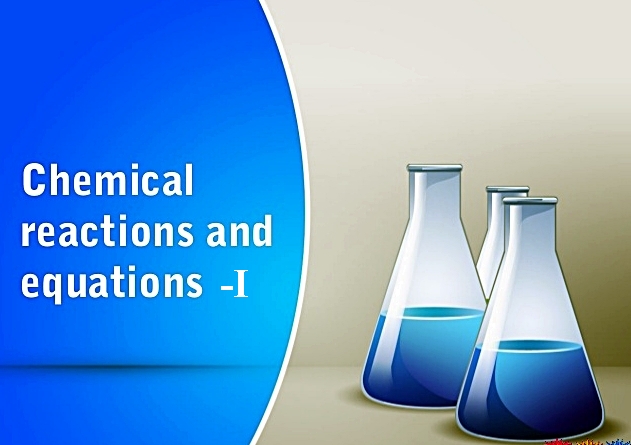METALS AND NON-METALS: (1)
CLASS – 10th
METALS
Metals form positive ions by losing electrons. Thus, metals are known as electropositive elements.
Physical properties of metals
a) Malleability: Property of a substance due to which it can be beaten into thin sheet. Metals are malleable. Gold and silver are the most malleable of all metals.
b) Ductility: Property of a substance by which it can be drawn into thin wires. Metals are ductile. Gold is the most ductile metal.
c) Conduction of heat: Metals are good conductors of heat. Silver and copper are best conductors while lead and mercury are the poor conductors of heat.
d) Conduction of electricity: Metals are good conductors of electricity, because of the presence of large number of free valence electrons.
e) Appearance of surface: Metals, in their pure state, have a shining surface also called metallic lustre. Metals on reacting with gases in atmosphere lose its shiny appearance when kept in air for a long time.
f) Hardness: Metals are generally hard with the exceptions of sodium and potassium that can be cut by knife. (Because of less force of attraction between the valence electron and the nucleus).
g) Density: Metals have high density except sodium and potassium.
h) Melting and boiling points: Generally metals have high melting and boiling points except for sodium, potassium, mercury, cesium, gallium. Tungsten has the highest melting point among metals (strong covalent bonds formed between tungsten atoms), while mercury has the lowest.
i) State at room temperature: Metals are generally solid at room temperature with an exception of mercury which is liquid. Non-metals are present in all three states, solids, liquids and gaseous, at room temperature.
j) Sonority: Property of producing sound on striking a hard surface. Metals are sonorous.
Chemical Properties of Metals
1. Reaction with oxygen: Most of the metals form respective metal oxides when reacting with oxygen.
Metal + Oxygen → Metal Oxide
Examples:
a) Reaction of Sodium with Oxygen: Sodium metal forms sodium oxide when reacts with oxygen.
Lithium, potassium, sodium, etc. are known as Alkali-metals. Alkali metals react vigorously with oxygen.
b) Reaction of Copper metal with Oxygen: Copper does not react with oxygen at room temperature but when burnt in air, it gives oxide.
c) Silver, gold and platinum do not combine with the oxygen of air even at high temperature. They are the least reactive.
Metal Oxides
Metal oxides are basic in nature. The aqueous solution of metal oxides turns red litmus blue.
Reaction of Metal oxides with Water: Most of the metal oxides are insoluble in water. Alkali metal oxides are soluble in water. Alkali metal oxides give strong base when dissolved in water.
a) Reaction of Sodium oxide with Water: Sodium oxide gives sodium hydroxide when reacts with water.
b) Reaction of Potassium oxide with Water: Potassium oxide gives potassium hydroxide when reacts with water.
Reaction of Zinc oxide and Aluminium oxide: Aluminium oxide and zinc oxide are insoluble in water. Aluminium oxide and zinc oxide are amphoteric in nature. An amphoteric substance shows both acidic and basic characters. It reacts with base like acid and reacts with an acid like a base.
I. When zinc oxide reacts with sodium hydroxide, it behaves like an acid. In this reaction, sodium zincate and water are formed.
II. Zinc oxide behaves like a base when reacts with acid. Zinc oxide gives zinc chloride and water on reaction with hydrochloric acid.
In a similar way, aluminium oxide behaves like a base when reacts with acid and behaves like acid when reacts with a base.
2. Reaction of metals with water: Metals form respective hydroxide and hydrogen gas when reacting with water.
Metal + Water → Metal hydroxide + Hydrogen
Most of the metals do not react with water. However, alkali metals react vigorously with water.
a) Reaction of Sodium metal with Water: Sodium metal forms sodium hydroxide and liberates hydrogen gas along with lot of heat when reacting with water.
b) Reaction of Calcium metal with Water: Calcium forms calcium hydroxide along with hydrogen gas and heat when react with water.
c) Reaction of Magnesium metal with Water: Magnesium metal reacts with water (hot) slowly and forms magnesium hydroxide and hydrogen gas.
When steam is passed over magnesium metal, magnesium oxide and hydrogen gas are formed.
d) Reaction of Aluminium metal with Water: Reaction of aluminium metal with cold water is too slow to come into notice. But when steam is passed over aluminium metal, aluminium oxide and hydrogen gas are produced.
2Al
+ 3H2O → Al2O3 + 2H2
e) Other metals usually do not react with water or react very slowly. Lead, copper, silver and gold do not react with steam. Thus, the order of reactivity of different metals towards water may be written as:
K > Na > Ca > Mg > Al > Zn > Fe > Pb > Cu > Ag > Au
3. Reaction of metals with dilute acid: Metals form respective salts when reacting with dilute acid.
Metal + dil. acid → Metal salt + Hydrogen
a) Reaction of Sodium metal with dilute hydrochloric acid: Sodium metal gives sodium chloride and hydrogen gas when react with dilute hydrochloric acid.
b) Reaction of Zinc with dilute sulphuric acid: Zinc sulphate and hydrogen gas are formed when zinc reacts with dilute sulphuric acid. This method is used in the laboratory to produce hydrogen gas.
Hydrogen (H2) gas is not evolved when metal is treated with nitric acid (HNO3): Nitric acid is strong oxidising agent and it oxidises the hydrogen gas (H2) liberated into water (H2O) and itself get reduced to some oxide of nitrogen like nitrous oxide, nitric oxide (NO) and nitrogen dioxide (NO2).
Reactivity Series of Metals: The order of reactivity of metal is known as Reactivity Series. Reactivity of elements decreases on moving from top to bottom in the given reactivity series.
Reactivity of some metals are given in descending order :
K > Na > Ca > Mg > Al > Zn > Fe > Pb > Cu
Aqua regia:
- Freshly prepared mixture of concentrated hydrochloric acid and concentrated nitric acid in the ratio of 3:1.
- Is a highly corrosive, fuming liquid and one of the few reagents able to dissolve gold and platinum.
4. Reaction of metals with solution of other metal salts: Reaction of metals with the solution of other metal salt is displacement reaction. In this reaction, more reactive metal displaces the less reactive metal from its salt.
Metal A + Salt of metal B → Salt of metal A + Metal B
Examples: Iron displaces copper from copper sulphate solution.
Physical properties of non-metals
Non – metals forms negative ions by accepting electrons. Thus, they are called as Electronegative elements.
a) Hardness: Non-metals are not hard. But the diamond is an exception; it is the hardest naturally occurring substance.
b) State: Non-metals may be solid, liquid or gas.
c) Lustre: Non-metals have a dull appearance. Diamond (because of its ability to reflect light that strikes on its surface) and iodine (effective nuclear charge is less and hence electrons are loosely bound therefore iodine is lustrous).
d) Sonority: Non-metals are not sonorous, i.e., they do not produce a typical sound on being hit.
e) Conduction: Non-metals are a bad conductor of heat and electricity. Graphite which is allotrope of carbon is a good conductor of electricity and is an exception (out of four electrons of carbon only three forms covalent bond, one electron is freely moving).
f) Malleability and ductility: Non-metals are brittle.
g) Melting and boiling point: Non-metals have generally low melting and boiling points.
h) Density: Most of the non-metals have low density.
i) Colour: Non-metals are in many colours.
Chemical properties of Non-metals:
1. Reaction of Non-metals with Oxygen: Non-metals form respective oxide when reacting with oxygen.
Non-metal + Oxygen → Non-metallic oxide
Sulphur gives sulphur dioxide when reacting with oxygen.
Non-metallic Oxide:
Non-metallic oxides are acidic in nature. The solution of non-metal oxides turns blue litmus red.
a) Carbon dioxide gives carbonic acid when dissolved in water.
b) Sulphur dioxide gives sulphurous acid when dissolved in water.
2. Non-metals do not react with water (or steam) to evolve Hydrogen gas. Non – metals are electronegative and are unable to break the bond between H and O in water. The non – metals cannot reduce hydrogen by donating electrons.
3. Non-metals do not react with dilute acids.
Reaction of Metal and Non-metal:
Metals form ionic bonds when they react with non-metals. Compounds so formed are known as Ionic Compounds.
Ions: Positive or negative charged atoms are known as ions. Ions are formed because of loss or gain of electrons.
a) Positive ion: A positive ion is formed because of the loss of electrons by an atom.
Example-
Sodium forms sodium ion because of the loss of one electron. Because of the loss of one electron, one positive charge comes over sodium.
b) Negative ion: A negative ion is formed because of the gain of an electron. Chlorine gains one electron in order to achieve a stable configuration. After the loss of one electron, chlorine gets one negative charge over it forming chlorine ion.
Ionic Bonds:
Bond formed between positive and negative ion is called Ionic Bond. Since, a compound is electrically neutral, so to form an ionic compound, negative and positive both ions must be combined.
Formation of Sodium Chloride (NaCl): In sodium chloride, sodium is a metal (alkali metal) and chlorine is a non-metal.
Sodium chloride is formed because of transfer of electrons. Thus, ionic bond is formed between sodium and chlorine. Since, sodium chloride is formed because of ionic bond, thus, it is called Ionic compound.
Properties of Ionic compound:
a) Ionic compounds are solid. Ionic bond has a greater force of attraction because of which ions attract each other strongly. This makes ionic compounds solid.
b) Ionic compounds have high melting and boiling points because force of attraction between ions of ionic compounds is very strong.
c) Ionic compounds generally dissolve in water.
d) Ionic compounds are generally insoluble in organic solvents; like kerosene, petrol, etc.
e) Ionic compounds do not conduct electricity in the solid state.
f) The solution of ionic compounds in water conducts electricity. This happens because ions present in the solution of ionic compound facilitate the passage of electricity by moving towards opposite electrodes.
g) Ionic compounds conduct electricity in the molten state.










0 Comments